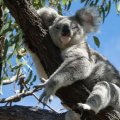Fossils of the world’s most primitive modern crocodilian have been discovered near the outback town of Isisford, in central-western Queensland, Australia.
The new animal, named Isisfordia duncani, is described today (June 14, 2006) in the prestigious Proceedings of the Royal Society journal by an international team of palaeontologists, headed by Dr Steve Salisbury from The University of Queensland’s (UQ) School of Integrative Biology.
“These are the most complete crocodilian fossils yet discovered in Australia, and provide us with valuable new insights into the early evolution of today’s crocodilians and their lifestyle as semi-aquatic ambush predators,” Dr Salisbury said.
“What’s more, their discovery in Queensland suggests that the ancestor of all living crocodilians was Australian.”
Dr Salisbury said it had been a long-standing mystery as to where and when the immediate ancestors of modern-day crocodilians – crocodiles, alligators and gharials – originated.
“The appearance of Isisfordia signalled the dawn of crocodilians as we know them today,” he said.
“Living 98-95 million years ago, Isisfordia predates the first recorded appearance of alligators and gharials by almost 20 million years, and the first true crocodiles by over 30 million.
“The discovery of Isisfordia in Australia indicates that the precursors to all three groups of modern crocodilians may have originated in Gondwana, rather than Europe or North America, as was previously thought.”
Dr Salisbury said Isisfordia was small compared with the majority of its modern descendants and looked like a dwarf version of the American alligator, but with a much flatter and longer snout.
“Adults appear to have been just over a metre in length, and probably weighed no more than about three kilograms,” he said.
“It may only have been small by today’s standards, but it represents a very important phase in the evolutionary history of crocodilians.”
Discovered by former Deputy Mayor of Isisford, Ian Duncan, after whom the new species has been named, the first fossils of Isisfordia were found in the mid-1990s in a dried-up creek bed on the outskirts of town.
Initial preparation of the fossils was undertaken at the Queensland Museum, with the remainder of the work being completed in Dr Salisbury’s Vertebrate Palaeontology Laboratory at UQ.
Kerry Geddes, Dr Salisbury’s Research Assistant, carried out most of the delicate preparation work on the more complete skeleton, which took two-and-half years and an estimated 3000 hours to complete.
“Unfortunately, the front portion of the skull was missing,” Dr Salisbury said.
“It was the only part of the skeleton that had been exposed to weathering.”
In April 2005, after four years of systematic exploration in the Isisford district, Dr Salisbury’s team finally found a complete fossilised skull that would put a face on the new crocodilian.
“Apart from a slight difference in size, the rear of this new skull is identical to the portion that is preserved on the first skeleton, so we are sure that they belong to the same species,” he said.
Dr Salisbury said Isisfordia had features that are characteristic of modern crocodilians, such as vertebrae that fit together via loose ball-and-socket joints, and a fully formed bony secondary palate – a kind of second roof to the mouth, that allows air to pass to the lungs without entering the oral cavity.
The research team comprised Dr Steve Salisbury (UQ), Dr Ralph Molnar (Museum of Northern Arizona), Dr Eberhard ‘Dino’ Frey (State Museum of Natural History, Karlsruhe, Germany) and Dr Paul Willis (University of New South Wales and ‘Catalyst’, ABC TV).
Their research was supported by funding from the Australian Research Council and was conducted in association with Isisford Shire Council, the Queensland Museum, Land Rover Australia and Winton Shire Council as part of the Winton Dinosaur Project. Additional funding was provided by UQ and the Frau von Ketter Foundation, Karlsruhe.
A display on Isisfordia will form the centrepiece of the Outer Barcoo Interpretation Centre in Isisford, which will be opened by Her Excellency, The Governor of Queensland, Ms Quentin Bryce, on July 14, 2006.
For further information about Isisfordia, visit www.uq.edu.au/dinosaurs
Media inquiries: Dr Steve Salisbury (+61 7 336 58548, +61 407 788 660, email s.salisbury@uq.edu.au) or Andrew Dunne at UQ Communications (telephone +61 7 3365 2802, +61 433 364 181).
Image inquiries: to view proof images of Isisfordia and stills from the field and lab work: http://omc.uq.edu.au/images/Isisford/
Captions and photo credits can be downloaded from this link:
http://omc.uq.edu.au/images/Isisford_captions/
High-resolution images can be obtained by contacting the Photo Library Coordinator, Diana Lilley (+61 7 336 52753, email d.lilley@uq.edu.au)
.jpg)



